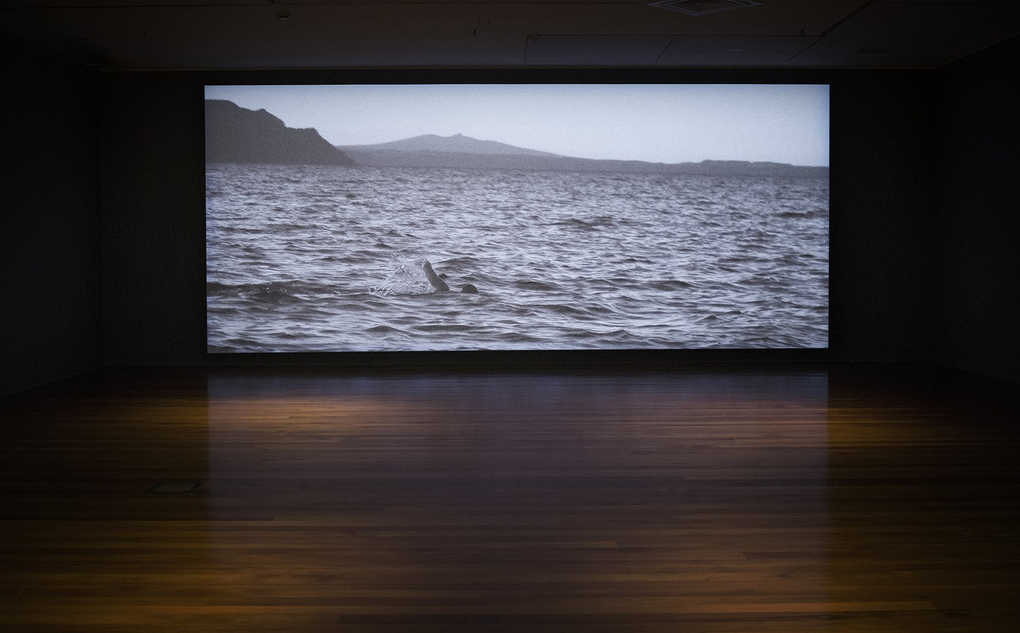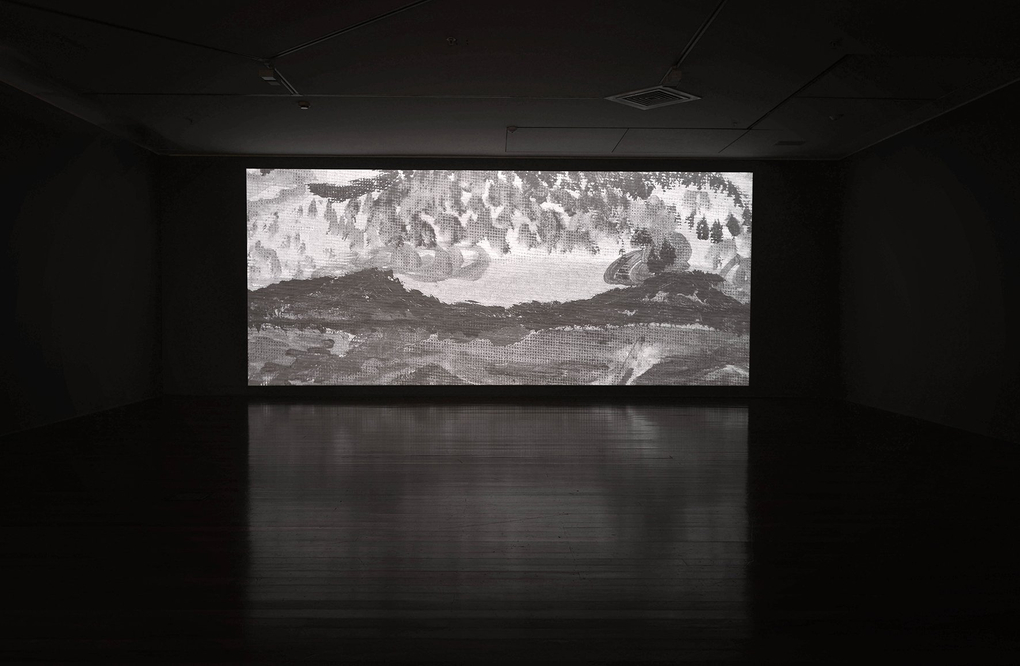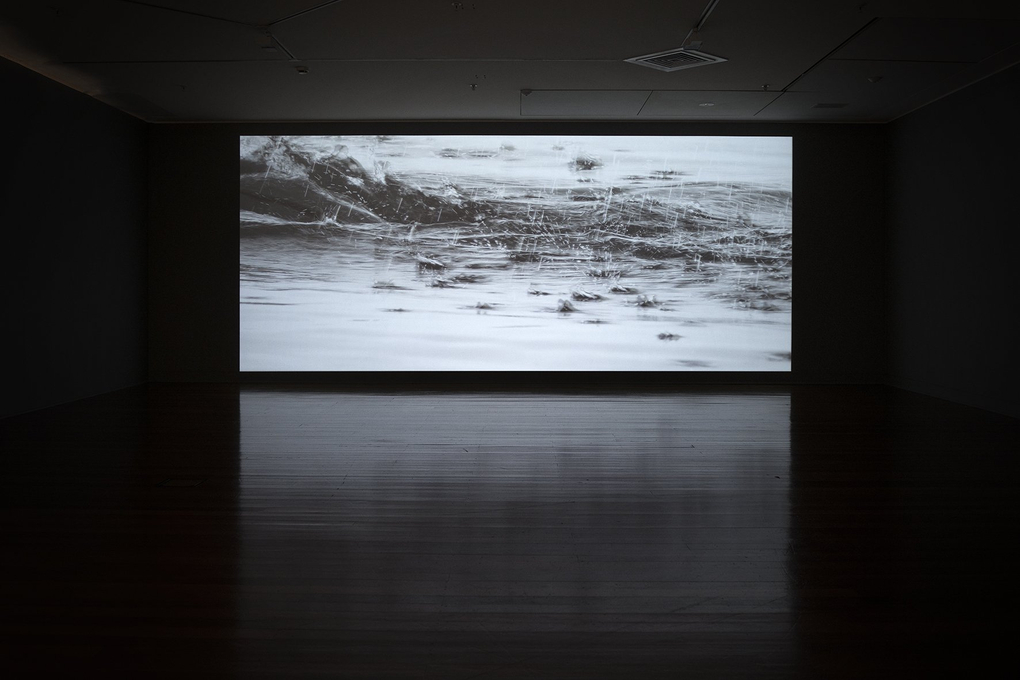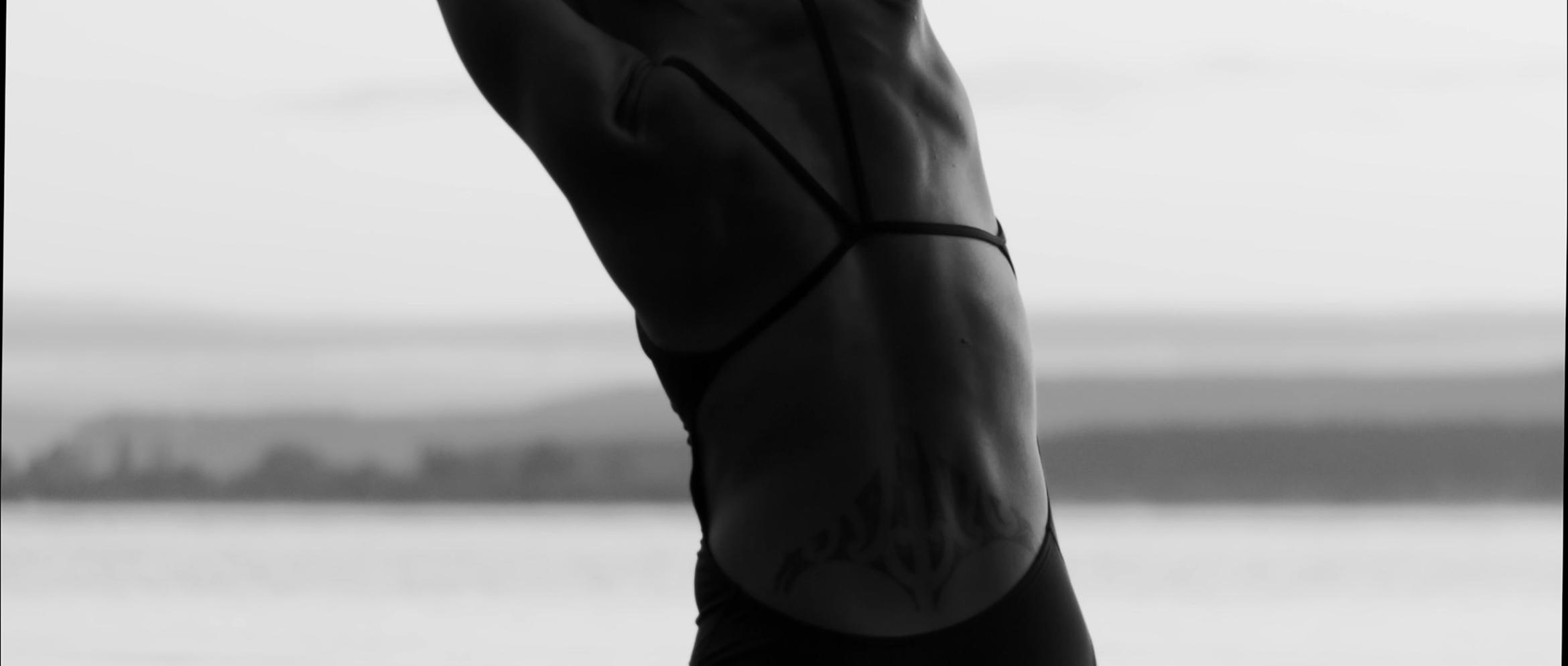This post presents three new pieces of writing in response to Shannon Te Ao's work what was or could be today (again) by:
John Ward Knox
Talia Marshall (Ngāti Kuia, Ngāti Rārua, Rangitāne ō Wairau, Ngāti Takihiku)
Jessica Koroneho Hinerangi Thompson-Carr (Ngāti Ruanui, Ngāruahine, Ngāpuhi).
In 2019 Bridget Reweti spoke to Shannon Te Ao for CIRCUIT's Uiuinga interview series about an exciting new work that was then in production. Te Ao talked about conceptual starting points for the work and the challenges of moving image installation.
The finished work, what was or could be today (again), is richly shot in black and white, and follows elite triathlete Ngarama Milner-Olsen in a swim across Taupō-nui-a-Tia. Images of her swim, and the preparation for it, are accompanied by a propulsive, lilting song written by Te Ao and Kurt Komene (Te Ātiawa, Taranaki Whānui) and performed by Te Āwhina Kaiwai-Wanikau (Ngāti Tūwharetoa).

Installation view, what was or could be today (again) (2021) Shannon Te Ao, Dunedin Public Art Gallery, 2021. Photo: Justin Spiers
Dunedin Public Art Gallery recently acquired and exhibited this work, so, to mark this show and to follow on from Reweti's and Te Ao's kōrero, CIRCUIT invited three Ōtepoti-based writers to respond to the exhibition. Over the final week of the show, CIRCUIT will iteratively publish these three new texts, one new piece every couple of days, by John Ward Knox, Talia Marshall (Ngāti Kuia, Ngāti Rārua, Rangitāne ō Wairau, Ngāti Takihiku), and Jessica Koroneho Hinerangi Thompson-Carr (Ngāti Ruanui, Ngāruahine, Ngāpuhi).
Our brief was open: write a short essay, poem, or prose prompted by Te Ao's work. As you'll read below, over the week, the three elegant responses are equally open, invoking the epic swim of Hinepoupou, the displacement of water, and ngā atua Māori.
Let’s return to water for a moment
By John Ward Knox
After all, we’ve only recently stepped out of it, in a geological sense. 400 million years or so, roughly a tenth of the time since the first bright spark of the carbon cycle—the emergence of life in the oceans. We retain that ratio as a birthmark in our physiology—we are still mostly water. I learned that factoid as a child, somewhere, maybe in a playground under a tree. I pictured it as a fraction, a line that divided the lower four-fifths of the body in blue and the upper fifth in yellow. This isn’t true of course, fractions are a tool to extract things from a suffused state. I remembered this moment sitting in front of Te Ao’s work, what was or could be today (again), as the athlete propelled herself through the water, four-fifths submerged and one-fifth emergent, as a kind of respiration, the human form became a way that some water escapes the body of the whole—like a fraction, a way to understand something much larger and complex.

Installation view, what was or could be today (again) (2021) Shannon Te Ao, Dunedin Public Art Gallery, 2021. Photo: Justin Spiers.
The video begins with extreme close-ups of a painting. The wall text announces that this is by the artist’s grandmother. It shows the dry remains of a wet process. Fine craquelure, exposed warp and weft of cotton fibres. Cotton is a thirsty plant interwoven into the story of human cruelty and has been both a vehicle of suppression but also of emancipation—think of khadi’s role in the satyagraha movement that led to India’s independence, or to clothing as a vessel of personal and generational resistance, or, as in this moment, of its use as a starting point of an artwork.
Archimedes was my eureka(!) moment for this work. what was or could be today (again) is well-produced, shiny and seductive so it felt like a celebration of the surface until I thought of volume, specifically the space that a human body occupies, what must be displaced for that being to exist. Archimedes sinks into the bath and notices the water level rise proportionally to his presence. And here, the swimmer propels herself forward and displaces her volume as she goes. I thought of the shoreline, nowhere visible in the video, and how intangible a single human body’s worth of water makes to the body of the lake. This felt like a tacit recognition of the impact of a single beings life, after the grandeur and beauty of their presence has passed. It felt like an almost intangible ripple on a distant shoreline.

Installation view, what was or could be today (again) (2021) Shannon Te Ao, Dunedin Public Art Gallery, 2021. Photo: Justin Spiers.
So let’s return to water for a moment. This body of water is something like the soft sadness of a homecoming embrace. Like the nostalgia of a grandmother’s painting, this embrace focuses on presence in the shadow of absence, but also most importantly on the responsibility that existence demands, of the futility of trying to find the hau at the expense of the wai.
John Ward Knox is an artist living and working in Karitane, Ōtepoti, in the shadow of Hikaroroa.
Woman with chubby knees playing the kōauau for her sisters
By Talia Marshall
No whale in the water in Whāngārā but Ricky is watching Maíra swim towards her mother/I tell her he better not lose her number and she wakes wanting a farm/her palms ready for the cattle and their sweet mysterious nostrils/the scarlet horse running circles on the island like the boy prophet waving his hands in Pōrangahau at the pearly hens that are nowhere to be seen
Hey Queenie/I say to Kerry because she is the rain and the melody/because she is the best thing to ever happen to Carpet Kingdom/because I have given up men and it makes me dangerous/I remind her that at school I was the better swimmer/she won the backstroke/but I would have won the war/except I couldn’t let the others see me in my togs/instead I cried in the changing rooms at my chubby reflection
I am taking Kerry back to Pōrangahau with Maíra because her bones have been there longer than mine but my Riria helped her brother carve the whare where Raina can karanga to the whale/my face lighting up at any suggestion of a curse or a quiz/of housie and crying legs eleven/but I can’t remember the last time I was in a lake/I can’t remember the last time I went swimming and the future recedes like my hair, smoky as dusk, a simmer, I read that an uncle knew death by the sudden black kutus falling from his comb
Thirty years since we met and became instant friends, more instant than coffee and Kerry was just back from burying Wikitoria in Waihi and I was turning into Polly. Before we knew we were whanaunga I laugh at the old nanny in the photo beside Polly/tag Kerry/and write: that lady in the photo with the bung eye is you/not knowing she was a Ropiha/not knowing the past was applying its moisturiser to our skin to plump up their old toffee sharing selves
And we are at the table drinking in Pōrangahau with Maíra and cousin Jenna and cousin Carla and cousin Lesley says you two girls have brought something good here but it is already so good here/the peaches with the tawny halos/the homekill in the freezer and pāua like indigo gold/Orlando and City gassing up the hangi and I am laughing to remind Maíra it’s a miracle the photos she dumped showed no sign of rain
Kerry tells the cousins she comes from Raukura and Wikitoria/she confesses to cousin Ralene that when she was in Turangi the boy came up to her and said Mum says you have to go home now/Kerry says she didn’t let that bitch get to her she was Home/she sighs and says Waihi is too pretty/she understands their venom/even tourists tried to take photos of her sister’s wedding hakari the same way she couldn’t take her eyes off her auntie’s silk nightie in the wharenui/the emerald fall of it/what are you looking at girl?
Kerry is having such a good time now with the cousins she turns to me and announces she is bulletproof and together we are the wide smile of the waka/sisters/at least/or cousins/look away/look away/we are the leopard losing its camouflage to the tree
And Maíra doesn’t swim here/but dreams of swimming back to Brazil/of taking her mother from the top floor of the house and tipping the ashes into the lake which is really the sea and this wharepuni we lie down in with the heater on all night to warm the crimson flesh of the whale
I don’t know how to help these swimmers/they still believe in love/they still want to wade right down into the water when I come from Hinepoupou who swam across Raukawakawa from Kāpiti to hunt her men down/those motherfuckers were useless as the kurī she turned to stone
I admit I am evil when the girls tease me but remind them that when I tried to cut my own throat with a ridiculous knife he filmed me to show his friends/so I’m not sorry for what I said/I mean/c’mon/it was baggage claim and his mother wasn’t hurting enough
Maíra says you two are talking some dark talk, I am just going to drink my milkshake from McDonalds/and then later Kerry says my hardness makes her sad
But I’m still too soft to call to the dead/when the living are so translucent with tohu/and Maíra hurts her arms towards her mother in the sea that has no salt but in the cave of her mouth breaching the surface
I want her to keep on carving up the water/the water is the future and the future is weightless in the water/the future is a mirror for the old stars and the hour she was born into will come back to her going mother mother/e hoa/we are swimming between islands and we don’t need kawakawa leaves to cover our eyes
*
Talia Marshall (Ngāti Kuia, Ngāti Rārua, Rangitāne ō Wairau, Ngāti Takihiku) is currently working on a creative nonfiction book which ranges from Ans Westra, the taniwha Kaikaiawaro to the musket wars. This project is an extension of her 2020 Emerging Māori Writers Residency at the IIML. Talia also writes poems and her latest, "Learning How to Behave" is in Landfall 241.
Indigeneity, intimacy and identity
By Jessica Koroneho Hinerangi Thompson-Carr
I
Ghost bumps sink and erupt
baby hairs journey across fleshed
out horizons rippling cold grey
sting ray negative spaces flood
healing pre-colonial balms
volcanic insertion slick as eel tail
tears from Ranginui yearning
for far away love
hā to breathe
hā between Tangaroa’s embrace
Hine-ahu-one lifts her roots and
beats her kōkowai down to
smooth blades swimming the
first ever swim of human history
a large body a race against rain
cast from swinging wings bouncing
elbows beaded ocean skin like
hail on concrete liquid concrete
flat whai writhing folds flat oil
life blood rushing between bodies
within bodies bodily water
between current highways and
intimate upwellings
limbs floating away from limbs
your waka is long ago buried
or fallen apart
sitting in storage or propped in
the dark museum so you have
to become your own waka
carry forward your people your
tīpuna on your wet wide back
sleeves of water droplets fan
out behind the elbows
Hine Moana is your kākahu now
her spit and tears baptise
and with her nails she engraves
Tukutuku lashings in red dirt
beneath English wildflowers
dance with us
shadow of the wave
watercolour legs
roll across a transparent valley
to Te Wai Pounamu
rationed breath
the land is the lung
the ocean is the heart
both entwine a rise and fall
the hair the tree the reed
he mauri te tangata
II
do you ever imagine yourself
back?
before bush was punctured with
train tracks and mountains
penetrated with tunnels?
do you ever imagine yourself
back?
in the womb of salty black
we imagine ourselves back
staring at young native green
exchanging pepeha for the first time
with kererū and tūī
with pāua and waiaua
the endurance of our tīpuna
across waves in the dark
was passed down through
threads of wero
Te Kore
Te Pō
Te Ao
bone liquifies
neck elongates
the torso is an arrow
piercing a spirit realm
we all crossed te moana
looking for more
and some of us were tricked
some of us knew
what we were doing
sinister intentions or
lust for the new
round and round
cyclical mauri ora
cyclical hongi
never-ending breath
a state of being
in this domain before the
next
we are fortune tellers in a sense
we māori
we see forward by looking back
vast landscapes of time between
us but there is no separation
we are threaded
tethered to each other
by whakapapa
ka mua
ka muri
walking backwards
into the future
kautāhoe
into the papa kāinga.
Jessica Koroneho Hinerangi Thompson-Carr is Ngāti Ruanui, Ngāruahine, and Ngāpuhi. She is 25 years old, born and bred in Ōtepoti. She achieved her degree in English and Art History in 2018, and her Masters Coursework in 2019. Jessica currently works as an artist, poet, and journalist, often under the name Māori Mermaid (@maori_mermaid on instagram). Her inspiration comes from her whakapapa and she is currently travelling Aotearoa in her little van trying to get to know her whenua.
